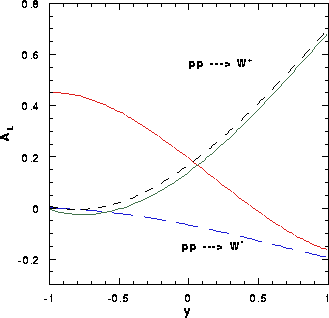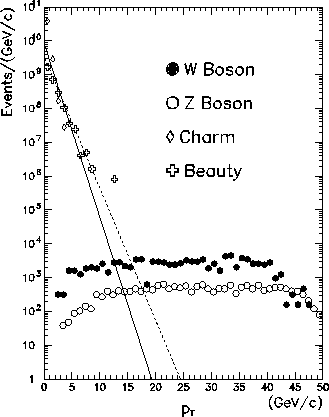



Next: Production
Up: Spin Physics with
Previous: Transversity Measurements in
Production of  and
and  bosons at
bosons at  at RHIC offers an important
opportunity in polarized quark structure function physics, complementary to continuum DY production.
As was emphasized in the RSC proposal[15], polarized-beam experiments present an opportunity
for new physics discovery in the domain where the weak interaction predominates.
at RHIC offers an important
opportunity in polarized quark structure function physics, complementary to continuum DY production.
As was emphasized in the RSC proposal[15], polarized-beam experiments present an opportunity
for new physics discovery in the domain where the weak interaction predominates.
The cross section for
 production is given by,
production is given by,

where  is the Fermi coupling constant. The structure functions are
evaluated at the mass scale of the vector bosons. Because
is the Fermi coupling constant. The structure functions are
evaluated at the mass scale of the vector bosons. Because  production occurs via a purely left-handed current (in the Standard Electroweak Model) the
helicity asymmetries are more complex than for the DY process. Bourrely and Soffer[19]
define three parity violating asymmetries and one parity conserving asymmetry. They further show,
with the reasonable
approximation,
production occurs via a purely left-handed current (in the Standard Electroweak Model) the
helicity asymmetries are more complex than for the DY process. Bourrely and Soffer[19]
define three parity violating asymmetries and one parity conserving asymmetry. They further show,
with the reasonable
approximation,  , that the parity violating single and double
spin asymmetries contain the same information. For
, that the parity violating single and double
spin asymmetries contain the same information. For  production the parity violating
single-spin (measurable with a single polarized beam) and parity-conserving double spin
asymmetries are given respectively by,
production the parity violating
single-spin (measurable with a single polarized beam) and parity-conserving double spin
asymmetries are given respectively by,

and,

Using the model for antiquark polarization described in Sect. 2.1
 has been calculated[19] for
has been calculated[19] for  collisions at
collisions at  ; the
calculations are shown in Fig 8.
; the
calculations are shown in Fig 8.

Figure 8: Parity violating asymmetries for  production at
production at
 . The solid lines use the antiquark
polarization as described in Ref. [19]; the
dashed lines correspond to
. The solid lines use the antiquark
polarization as described in Ref. [19]; the
dashed lines correspond to  .
.
Polarization effects in  production are measured by detection of single high-
production are measured by detection of single high- muons, an inclusive process that integrates over a range of
muons, an inclusive process that integrates over a range of  and
and  . The PHENIX
end caps have very short (
. The PHENIX
end caps have very short ( ) decay distances which effectively discriminate
against muons from pion and kaon decay and are hence ideal for high-momentum
single muon detection. The principal background to the
) decay distances which effectively discriminate
against muons from pion and kaon decay and are hence ideal for high-momentum
single muon detection. The principal background to the  signal is from muon decay of heavy
quarks. Based on experience at
signal is from muon decay of heavy
quarks. Based on experience at  colliders[28,29], the most effective method of
discriminating against heavy-quark decays is to use only the highest
colliders[28,29], the most effective method of
discriminating against heavy-quark decays is to use only the highest  part of the
spectrum.
part of the
spectrum. Figure 9, an ISAJET calculation for the
PHENIX end caps at
Figure 9, an ISAJET calculation for the
PHENIX end caps at  , shows that the region
, shows that the region  is dominated by
is dominated by
 decays. This threshold results in a combined acceptance in the two end caps of 10%,
yielding production of
decays. This threshold results in a combined acceptance in the two end caps of 10%,
yielding production of  24K (9K)
24K (9K)  (
( ) events with
) events with
 .
.

Figure 9: Production of single muons from charm, beauty, and vector boson
decay into the PHENIX end caps at  using
ISAJET.
The lines show two possible extrapolations of the beauty decays
to higher transverse momenta where the calculation has insufficient
statistical precision.
using
ISAJET.
The lines show two possible extrapolations of the beauty decays
to higher transverse momenta where the calculation has insufficient
statistical precision.
The high  cut also limits the acceptance to the large
cut also limits the acceptance to the large  kinematic range,
kinematic range,  , where simplifications in the spin asymmetries similar to those discussed in Sect. 2.1
apply. Under these conditions Eq. 9 yields,
, where simplifications in the spin asymmetries similar to those discussed in Sect. 2.1
apply. Under these conditions Eq. 9 yields,

while Eq. 10 reduces to,

The second step for  production shows the similarity to the DY process, Eq.
5. Thus both the parity violating and parity conserving asymmetries provide a
measure of the ratio of the polarized to unpolarized antiquark structure functions at
production shows the similarity to the DY process, Eq.
5. Thus both the parity violating and parity conserving asymmetries provide a
measure of the ratio of the polarized to unpolarized antiquark structure functions at
 (range roughly
(range roughly  ). Based on the number of
). Based on the number of  events estimated
above, the errors on
events estimated
above, the errors on  from the use of Eq. 11 would be
comparable to those obtainable via the DY process in the same
from the use of Eq. 11 would be
comparable to those obtainable via the DY process in the same  range.
range.




Next: Production
Up: Spin Physics with
Previous: Transversity Measurements in
Converted to HTML from LaTeX by W. Wayne Kinnison
Sun Nov 5 18:47:30 MST 1995
 and
and  bosons at
bosons at  at RHIC offers an important
opportunity in polarized quark structure function physics, complementary to continuum DY production.
As was emphasized in the RSC proposal[15], polarized-beam experiments present an opportunity
for new physics discovery in the domain where the weak interaction predominates.
at RHIC offers an important
opportunity in polarized quark structure function physics, complementary to continuum DY production.
As was emphasized in the RSC proposal[15], polarized-beam experiments present an opportunity
for new physics discovery in the domain where the weak interaction predominates.
 production is given by,
production is given by,

 is the Fermi coupling constant. The structure functions are
evaluated at the mass scale of the vector bosons. Because
is the Fermi coupling constant. The structure functions are
evaluated at the mass scale of the vector bosons. Because  production occurs via a purely left-handed current (in the Standard Electroweak Model) the
helicity asymmetries are more complex than for the DY process. Bourrely and Soffer[
production occurs via a purely left-handed current (in the Standard Electroweak Model) the
helicity asymmetries are more complex than for the DY process. Bourrely and Soffer[ , that the parity violating single and double
spin asymmetries contain the same information. For
, that the parity violating single and double
spin asymmetries contain the same information. For  production the parity violating
single-spin (measurable with a single polarized beam) and parity-conserving double spin
asymmetries are given respectively by,
production the parity violating
single-spin (measurable with a single polarized beam) and parity-conserving double spin
asymmetries are given respectively by,


 has been calculated[
has been calculated[ collisions at
collisions at  ; the
calculations are shown in Fig
; the
calculations are shown in Fig 
 production at
production at
 . The solid lines use the antiquark
polarization as described in Ref. [
. The solid lines use the antiquark
polarization as described in Ref. [ .
. production are measured by detection of single high-
production are measured by detection of single high- muons, an inclusive process that integrates over a range of
muons, an inclusive process that integrates over a range of  and
and  . The PHENIX
end caps have very short (
. The PHENIX
end caps have very short ( ) decay distances which effectively discriminate
against muons from pion and kaon decay and are hence ideal for high-momentum
single muon detection. The principal background to the
) decay distances which effectively discriminate
against muons from pion and kaon decay and are hence ideal for high-momentum
single muon detection. The principal background to the  signal is from muon decay of heavy
quarks. Based on experience at
signal is from muon decay of heavy
quarks. Based on experience at  colliders[
colliders[ part of the
spectrum.
part of the
spectrum. , shows that the region
, shows that the region  is dominated by
is dominated by
 decays. This threshold results in a combined acceptance in the two end caps of 10%,
yielding production of
decays. This threshold results in a combined acceptance in the two end caps of 10%,
yielding production of  24K (9K)
24K (9K)  (
( ) events with
) events with
 .
.

 using
ISAJET.
The lines show two possible extrapolations of the beauty decays
to higher transverse momenta where the calculation has insufficient
statistical precision.
using
ISAJET.
The lines show two possible extrapolations of the beauty decays
to higher transverse momenta where the calculation has insufficient
statistical precision. cut also limits the acceptance to the large
cut also limits the acceptance to the large  kinematic range,
kinematic range,  , where simplifications in the spin asymmetries similar to those discussed in Sect. 2.1
apply. Under these conditions Eq.
, where simplifications in the spin asymmetries similar to those discussed in Sect. 2.1
apply. Under these conditions Eq. 

 production shows the similarity to the DY process, Eq.
production shows the similarity to the DY process, Eq.
 (range roughly
(range roughly  ). Based on the number of
). Based on the number of  events estimated
above, the errors on
events estimated
above, the errors on  from the use of Eq.
from the use of Eq.  range.
range.